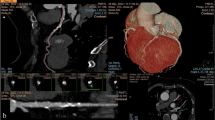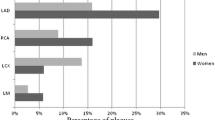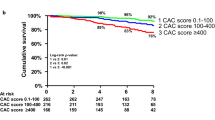Abstract
Our aim was to analyze its diagnostic and prognostic value in patients with high coronary calcium score (CCS). A total of 113 patients with CCS > 400 were included. Significant coronary artery disease (CAD) was defined as stenosis ≥ 50%. Invasive coronary angiography and major cardiovascular events were recorded. The CCS and heart rate during the acquisition were significantly lower in the diagnostic coronary computed tomography angiography (CCTA) group. The cut-off value of CCS to establish the diagnostic utility of CCTA was 878. The rate of cardiovascular events was 9.3%. The positive predictive value of CCTA to detect significant CAD was 73.5% and the negative predictive value for predicting cardiovascular events was 96%. In patients with high CCS, CCTA is useful to evaluate CAD, especially when the CCS is lower or equal to 878; moreover, the prognostic value of CCTA is better in patients where significant CAD has been ruled out.




Similar content being viewed by others
Abbreviations
- CCTA:
-
Coronary computed tomography angiography
- CCS:
-
Coronary calcium score
- CAD:
-
Coronary artery disease
- CADs:
-
Significant coronary artery disease
- CVRF:
-
Cardiovascular risk factors
- SD:
-
Standard deviation
- MACEs:
-
Major adverse cardiovascular events
References
Budoff, M. J., Dowe, D., Jollis, J. G., Gitter, M., Sutherland, J., Halamert, E., Scherer, M., Bellinger, R., Martin, A., Benton, R., Delago, A., & Min, J. K. (2008). Diagnostic performance of 64-multidetector row coronary computed tomographic angiography for evaluation of coronary artery stenosis in individuals without known coronary artery disease: Results from the prospective multicenter ACCURACY (assessment by coronary computed tomographic angiography of individuals undergoing invasive coronary angiography) trial. Journal of the American College of Cardiology, 52, 1724–1732.
Rumberger, J. A., Simons, D. B., Fitzpatrick, L. A., Sheedy, P. F., & Schwartz, R. S. (1995). Coronary artery calcium area by electron beam computed tomography and coronary atherosclerotic plaque area: A histo-pathologic correlative study. Circulation, 92, 2157–2162.
Budoff, M. J., Shaw, L. J., Liu, S. T., Weinstein, S. R., Mosler, T. P., Tseng, P. H., Flores, F. R., Callister, T. Q., Raggi, P., & Berman, D. S. (2007). Long-term prognosis associated with coronary calcification: Observations from a registry of 25,253 patients. Journal of the American College of Cardiology, 49, 1860–1870.
Zhang, S., Levin, D. C., Halpern, E. J., Fischman, D., Savage, M., & Walinsky, P. (2008). Accuracy of MDCT in assessing the degree of stenosis caused by calcified coronary artery plaques. American Journal of Roentgenology, 191, 1676–1683.
De Agustin, J. A., Marcos-Alberca, P., Fernández-Golfin, C., Feltes, G., Nuñez-Gil, I. J., Almeria, C., Rodrigo, J. L., Arrazola, J., Pérez de Isla, L., Macaya, C., & Zamorano, J. (2013). Should computed tomography coronary angiography be aborted when the calcium score excedes a certain threshold in patients with chest pain? International Journal of Cardiology, 167, 2013–2017.
Den Dekker, M. A., de Smet, K., de Bock, G. H., Tio, R. A., Oudkerk, M., & Vliegenthart, R. (2012). Diagnostic performance of coronary CT angiography for stenosis detection according to calcium score: systematic review and meta-analysis. European Radiology, 22, 2688–2698.
De Agustín, J. A., Gómez de Diego, J. J., Marcos-Alberca, P., Mahía, P., Rodrigo, J. L., Luaces, M., Núñez-Gil, I. J., Ferreiros, J., Bustos, A., Cabeza, B., García-Fernández, M. Á., Macaya, C., & Pérez de Isla, L. (2018). Impacto de la puntuación de calcio en la concordancia entre la tomografía computarizada con multidetectores y la coronariografía invasiva. Revista Española de Cardiología (Engl Ed), 71, 105–109.
Cho, I., Chang, H. J., ÓHartaigh, B., Shin, S., Sung, J. M., Lin, F. Y., Achenbach, S., Heo, R., Berman, D. S., Budoff, M. J., Callister, T. Q., Al-Mallah, M. H., Cademartiri, F., Chinnaiyan, K., Chow, B. J., Dunning, A. M., De Lago, A., Villines, T. C., Hadamitzky, M., Hausleiter, J., Leipsic, J., Shaw, L. J., Kaufmann, P. A., Cury, R. C., Feuchtner, G., Kim, Y. J., Maffei, E., Raff, G., Pontone, G., Andreini, D., & Min, J. K. (2015). Incremental prognostic utility of coronary CT angiography for asymptomatic patients based upon extent and severity of coronary artery calcium: results from the COronary CT Angiography EvaluatioN For Clinical Outcomes InteRnational Multicenter (CONFIRM) study. European Heart Journal, 36, 501–508.
Agatston, A. S., Janowitz, W. R., Hildner, F. J., Zusmer, N. R., ViamonteJr, M., & Detrano, R. (1990). Quantification of coronary artery calciumusing ultrafast computed tomography. Journal of the American College of Cardiology, 15, 827–832.
Cerqueira, M. D., Weissman, N. J., Dilsizian, V., Jacobs, A. K., Kaul, S., Laskey, W. K., Pennell, D. J., Rumberger, J. A., Ryan, T., Verani, M. S., & American Heart Association Writing Group on Myocardial Segmentation and Registration for Cardiac Imaging. (2002). Standardized myocardial segmentation and nomenclature for tomographic imaging of the heart: A state-ment for healthcare professionals from the Cardiac Imaging Committee of the Council on Clinical Cardiology of the American Heart Association. Circulation, 105, 539–542.
Cury, R. C., Abbara, S., Achenbach, S., Agatston, A., Berman, D. S., Budoff, M. J., Dill, K. E., Jacobs, J. E., Maroules, C. D., Rubin, G. D., Rybicki, F. J., Schoepf, U. J., Shaw, L. J., Stillman, A. E., White, C. S., Woodard, P. K., & Leipsic, J. A. (2016). CAD-RADS ™ Coronary Artery Disease- Reporting and Data System. An expert consensus document of the Society of Cardiovascular Computed Tomography (SCCT), the American College of Radiology (ACR) and the North American Society for Cardiovascular Imaging (NASCI). Endorsed by the American College of Cardiology. Journal of Cardiovascular Computed Tomography, 10(4), 269–281.
Task Force Members, Montalescot, G., Sechtem, U., Achenbach, S., Andreotti, F., Arden, C., Budaj, A., Bugiardini, R., Crea, F., Cuisset, T., Di Mario, C., Ferreira, J. R., Gersh, B. J., Gitt, A. K., Hulot, J. S., Marx, N., Opie, L. H., Pfisterer, M., Prescott, E., Ruschitzka, F., Sabaté, M., Senior, R., Taggart, D. P., van der Wall, E. E., Vrints, C. J., ESC Committee for Practice Guidelines, Zamorano, J. L., Achenbach, S., Baumgartner, H., Bax, J. J., Bueno, H., Dean, V., Deaton, C., Erol, C., Fagard, R., Ferrari, R., Hasdai, D., Hoes, A. W., Kirchhof, P., Knuuti, J., Kolh, P., Lancellotti, P., Linhart, A., Nihoyannopoulos, P., Piepoli, M. F., Ponikowski, P., Sirnes, P. A., Tamargo, J. L., Tendera, M., Torbicki, A., Wijns, W., Windecker, S., Document Reviewers, Knuuti, J., Valgimigli, M., Bueno, H., Claeys, M. J., Donner-Banzhoff, N., Erol, C., Frank, H., Funck-Brentano, C., Gaemperli, O., Gonzalez-Juanatey, J. R., Hamilos, M., Hasdai, D., Husted, S., James, S. K., Kervinen, K., Kolh, P., Kristensen, S. D., Lancellotti, P., Maggioni, A. P., Piepoli, M. F., Pries, A. R., Romeo, F., Rydén, L., Simoons, M. L., Sirnes, P. A., Steg, P. G., Timmis, A., Wijns, W., Windecker, S., Yildirir, A., & Zamorano, J. L. (2013). 2013 ESC Guidelines on the management of stable coronary artery disease. European Heart Journal, 34, 2949–3003.
Nakazato, R., Arsanjani, R., Achenbach, S., Gransar, H., Cheng, V. Y., Dunning, A., Lin, F. Y., Al-Mallah, M., Budoff, M. J., Callister, T. Q., Chang, H. J., Cademartiri, F., Chinnaiyan, K., Chow, B. J., Delago, A., Hadamitzky, M., Hausleiter, J., Kaufmann, P., Raff, G., Shaw, L. J., Villines, T., Cury, R. C., Feuchtner, G., Kim, Y. J., Leipsic, J., Berman, D. S., & Min, J. K. (2014). Age-related risk of major adverse cardiac event risk and coronary artery disease extent and severity by coronary CT angiography: results from 15 187 patients from the International Multisite CONFIRM Study. European Heart Journal Cardiovascular Imaging, 15, 586–594.
Abdulla, J., Pedersen, K. S., Budoff, M., & Kofoed, K. F. (2012). Influence of coronary calcification on the diagnostic accuracy of 64-slice computed tomography coronary angiography: a systematic review and meta-analysis. The International Journal of Cardiovascular Imaging, 28, 943–953.
Arbab-Zadeh, A., Miller, J. M., Rochitte, C. E., Dewey, M., Niinuma, H., Gottlieb, I., Paul, N., Clouse, M. E., Shapiro, E. P., Hoe, J., Lardo, A. C., Bush, D. E., de Roos, A., Cox, C., Brinker, J., & Lima, J. A. (2012). Diagnostic accuracy of computed tomography coronary angiography according to pre-test probability of coronary artery disease and severity of coronary arterial calcification. The CORE-64 (Coronary Artery Evaluation Using 64-Row Multidetector Computed Tomography Angiography) International Multicenter Study. Journal of the American College of Cardiology, 59, 379–387.
Pundziute, G., Schuijf, J. D., Jukema, J. W., Lamb, H. J., de Roos, A., van der Wall, E. E., & Bax, J. J. (2007). Impact of coronary calcium score on diagnostic accuracy of multislice computed tomography coronary angiography for detection of coronary artery disease. Journal of Nuclear Cardiology, 14, 36–43.
Qu, W., Le, T. T., Azen, S. P., Xiang, M., Wong, N. D., Doherty, T. M., & Detrano, R. C. (2003). Value of coronary artery calcium scanning by computed tomography for predicting coronary heart disease in diabetic subjects. Diabetes Care, 26(3), 905–910.
Schroeder, S., Kopp, A. F., Kuettner, A., Burgstahler, C., Herdeg, C., Heuschmid, M., Baumbach, A., Claussen, C. D., Karsch, K. R., & Seipel, L. (2002). Influence of heart rate on vessel visibility in noninvasive coronary angiography using new multislice computed tomography: experience in 94 patients. Clinical Imaging, 26, 106–111.
Ho, J. S., Fitzgerald, S. J., Stolfus, L. L., Wade, W. A., Reinhardt, D. B., Barlow, C. E., & Cannaday, J. J. (2008). Relation of a coronary artery calcium score higher than 400 to coronary stenosis undected using multidetector computed tomography and to traditional cardiovascular risk factors. The American Journal of Cardiology, 101, 1444–1447.
Hochman, J. S., Reynolds, H. R., & Bangalore, S. (2019). O’Brien SM, Alexander KP, Senior R, et al. Baseline charascteristics and risk profile of participants in the ISCHEMIA randomized clínica trial. JAMA Cardiology, 4(3), 273–286.
International Study of Comparative Health Effectiveness With Medical and Invasive Approaches – ISCHEMIA. American Heart Association, Scientific Sessions 2019. https://www.acc.org/latest-in-cardiology/clinical-trials/2019/11/15/17/27/ischemia; www.ischemiatrial.org).
Douglas, P. S., Pontone, G., Hlatky, M. A., Patel, M. R., Norgaard, B. L., Byrne, R. A., et al. (2015 Dec 14). Clinical outcomes of fractional flow reserve by computed tomographic angiography-guided diagnostic strategies vs usual care in patients with suspected coronary artery disease: the prospective longitudinal trial of FFR (CT): outcome and resource impacts study. European Heart Journal, 36(47), 3359–3367.
Pontone, G., Andreini, D., Guaricci, A. I., Baggiano, A., Guglielmo, M., Muscogiuri, G., et al. (2019). Incremental diagnostic value of stress computed tomography myocardial perfusion with whole-heart coverage CT scanner in intermediate to high risk symptomatic patients suspected of coronary artery disease. JACC: Cardiovascular Imaging, 12(2), 338–349.
Min, J. K., Shaw, L. J., Devereux, R. B., Okin, P. M., Weinsaft, J. W., Russo, D. J., Lippolis, N. J., Berman, D. S., & Callister, T. Q. (2007). Prognostic value of multidetector coronary computed tomographic angiography for prediction of all-cause mortality. Journal of the American College of Cardiology, 50, 1161–1170.
Dedic, A., Genders, T., Ferket, B., Galema, T., Mollet, N., Moelker, A., et al. (2011). Stable angina pectoris: head-to-head comparison of prognostic value of cardiac CT and exercise testing. Radiology, 261, 428–436.
Hou, Z. H., Lu, B., Gao, Y., Jiang, S. L., Wang, Y., Li, W., & Budoff, M. J. (2012). Prognostic value of coronary CT angiography and calcium score for major adverse cardiac events in outpatients. JACC: Cardiovascular Imaging, 5(10), 990–999.
Raff, G. L., Gallagher, M. J., O’Neill, W. W., & Goldstein, J. A. (2005). Diagnostic accuracy of noninvasive coronary angiography using 64-slice spiral computed tomography. Journal of the American College of Cardiology, 46(3), 552–557.
Acknowledgments
Laura Fernández-Friera was acknowledged for her work in the follow-up of patients.
Funding
This study was supported by Comunidad de Madrid through the programme AORTASANA-CM; B2017/BMD-3676 co-financed by the European Social Fund (ESF).
Author information
Authors and Affiliations
Corresponding author
Ethics declarations
Conflict of Interest
All authors declare that they have no conflict of interest.
Ethical Approval
All procedures performed were in accordance with the ethical standards of the institutional and/or national research committee and with the 1964 Helsinki declaration and its later amendments or comparable ethical standards. Informed consent was obtained from all individual participants included in the study.
Additional information
Associate Editor Paul J. R. Barton oversaw the review of this article
Clinical Relevance of the Manuscript
We have shown that CCTA is useful for evaluating CAD in almost 90% of patients with extensive coronary calcification, especially if the CCS is lower or equal to 878 and the heart rate is optimized. Cardiovascular events are lower when CCTA excluded CADs, which provides prognostic value in the medium term. Thus, a high CCS should, therefore, not be considered as a contraindication for CCTA.”
Publisher’s Note
Springer Nature remains neutral with regard to jurisdictional claims in published maps and institutional affiliations.
All authors takes responsibility for all aspects of the reliability and freedom from bias of the data presented and their discussed interpretation.
Rights and permissions
About this article
Cite this article
Díaz-Antón, B., Solís, J., Morales, R.D. et al. Diagnostic and Prognostic Value of Coronary Computed Tomography Angiography in Patients with Severe Calcification. J. of Cardiovasc. Trans. Res. 14, 131–139 (2021). https://doi.org/10.1007/s12265-020-09977-4
Received:
Accepted:
Published:
Issue Date:
DOI: https://doi.org/10.1007/s12265-020-09977-4




